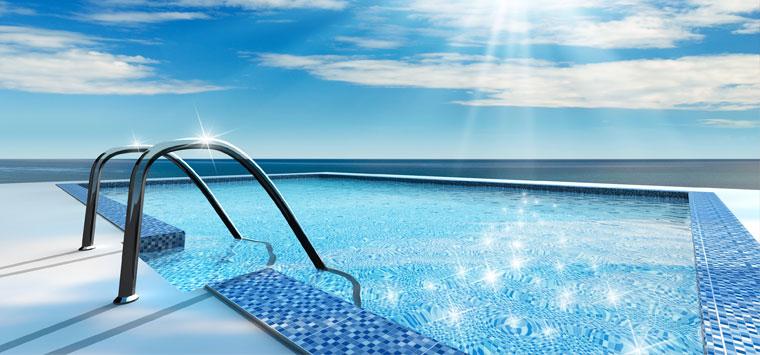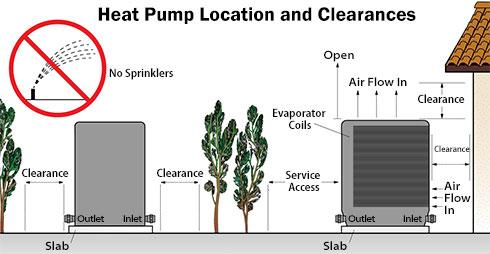Heat Pump Pool and Spa Heaters

Heat pump pool and spa heaters absorb heat from the air and transfer it to the water, making the heating process efficient, ecological, and cost effective.
Product Basics
The heat pump pool heater extracts heat from the warm ambient air by using a fan to draw ambient air across the evaporator coil in the heat pump pool heater. Liquid refrigerant within the evaporator coil absorbs this heat and the refrigerant turns to a gas. The warm gas then passes through the compressor. The compressor increases the heat, creating a very hot gas that then passes through the condenser/heat exchanger. The condenser/heat exchanger transfers this refrigerant heat energy to the pool water pumping through the unit. The heated water is then returned to the pool. The hot gas, as it flows through the condenser/heat exchanger, returns to liquid form and is moved back to the evaporator coil where the whole process begins again.
One of the biggest misconceptions about a heat pump pool heater operation is what happens to the energy used to run the unit. For the most part, this energy does not go into the water. The electricity powering the unit operates the compressor and fan, along with the other controls and electronics. The electrical input energy if converted to BTUs only amounts to roughly 14,000 BTU. The bulk of the BTU output comes from the heat energy extracted from the air. Typical Coefficient of Performance (COP) values for heat pump pool heaters are equal to 4.0 – 6.0.
Heat pump pool heaters are best utilized to maintain a constant water temperature; they are not intended to provide instant or fast heating. The intended use of a heat pump pool heater is to set it at the desired temperature to maintain. A heat pump pool heater will turn on and off automatically to maintain the desired temperature, much like a home HVAC unit. The use of a solar/pool cover is highly recommended. This will ensure the maximum energy savings and reasonable heat up times.
Typical Installation and Maintenance Considerations
Installation of a heat pump pool heater must be performed by a qualified installer or service agency, and must conform to all national, state, and local codes. Heat pump pool heater installation will require plumbing connections to the pool circulation system. Units are typically placed on a level surface for proper condensate drainage. Most heat pump pool heaters provide controls for both pool and spa heat settings. Proper clearances should be maintained from other AC units and gas pool heaters. See manufacturer installation & operation instruction manuals.
The illustration below shows typical minimum clearances for installation of the heat pump pool heater. However, actual minimum clearances are specified by the manufacturer.

Homeowners should inspect their heat pump pool heater on a regular basis, particularly after abnormal weather conditions, using the following guidelines:
- Make sure the service panel of the unit is accessible for future service.
- Keep the top and surrounding areas of the heat pump pool heater clear of all debris.
- Keep all plants and shrubs trimmed and away from the heat pump pool heater.
- Keep lawn sprinkler heads from spraying on the heat pump pool heater to prevent corrosion and damage.
- If the unit is installed under a roof edge, install a gutter or diverter to prevent excessive water and debris from pouring down into the unit.
- Do not use the heat pump pool heater if any part has been under water. Immediately call a qualified professional technician to inspect the unit and replace any parts that have been submerged.
- Visually inspect and clear any debris from the condensate drainage areas.
- Keep the air flow discharge and intake areas clear of debris.
- Be sure the condensate water can drain away from the heat pump pool heater. NOTE: It is perfectly normal for condensate to flow from the unit on hot, humid days during operation.
Standards
ANSI/AHRI Standard 1160(I-P), Performance Rating of Heat Pump Pool Heaters, establishes definitions, classifications, and requirements for testing, rating and operating heat pump pool heaters. It applies to the rating and testing of complete factory-made heat pump pool heater refrigeration systems.
AHRI Certification
AHRI’s Heat Pump Pool Heater certification program applies to factory-made assembly heat pump pool heaters, which contain the air moving device, compressor, refrigerant-to-water heat exchanger and air-to-refrigerant heat exchanger using ambient air as the heat source. It applies to heat pump pool heaters with 60Hz single-phase or three-phase compressors. Search the AHRI Directory of Certified Product Performance at www.ahridirectory.org.
Certification Program Participants
AquaCal, Inc.
Built Right Pool Heaters LLC
G & F Manufacturing
Hayward Industries, Inc.
Nirvana Chauffe Piscine/Heat Pump Inc.
Pentair Aquatic Systems
Thermeau Industries
Zodiac Pool Systems, Inc.
Glossary of Terms
C.O.P. — Coefficient Of Performance. Efficiency measurement for heat pump pool heaters. BTU Output ÷ BTU Input = C.O.P. Compressor — Compresses and pumps refrigerant to meet heating requirements.
Heat exchanger — Transfers heat from the hot refrigerant gases to the pool/spa water.
AHRI Member Manufacturers
AquaCal, Inc.
AquaPRO Systems
Built Right Pool Heaters LLC
G & F Manufacturing
Hayward Industries, Inc.
Pentair Aquatic Systems
Raypak
Thermeau Industries Inc.
Zodiac Pool Systems, Inc.